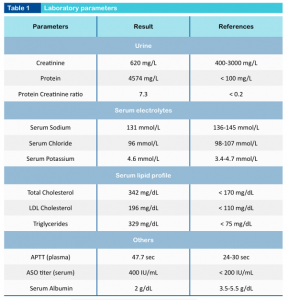This post is adapted for the Health & Medical Case Studies created by the Master of Medical Biotechnology program of the University of Windsor. This work licensed under a Creative Commons Attribution-NonCommercial (CC BY-NC-ND) 4.0 International License.
1 Case 1-2020: A 2-year-old boy with fever, edema and oliguria
Case Report on Pediatric Nephrotic Syndrome. EJIFCC, 2020, 31(2), 164–168.
Prince, S., Naresh, K., & Tulasi, R.
Case Summary 1
A 2-year-old boy is presented with a high-grade continuous fever with chills and rigor, a wet cough, swelling over the face, and low urine output. Physical examinations revealed pitting edema found in both legs. Laboratory investigations showed proteinuria, decreased levels of C3 and albumin, prolonged APTT (activated partial thromboplastin time), high urine protein/creatinine ratios along hyperlipidemia. The patient was treated and his condition improved gradually.
Learning Objectives
- Identifying the signs of suspected renal disease in children.
- Recognize the clinical and laboratory findings associated with pediatric renal disease.
- Discuss the common clinical laboratory tests used to assess renal diseases.
- Familiarizing and defining new medical terminology associated with pediatric renal disease.
Clinical History 1
- Age: 2 years old
- Sex: Male
Medical History 1
- No medical issues.
- He was delivered by C-section and weighed 2.75 kg after birth.
Drug History 1
- Not applicable.
Symptoms 1
- High-grade continuous fever is associated with chills and rigor.
- Cough (wet cough more in amount) with whitish color sputum which was not foul-smelling.
- Swelling over the face was present which initially started around the peri-orbital (which is more during the morning) and gradually progressed to the face which decreases by evening.
- Decreased urine output (oliguria).
Examinations (Clinical Assays/Tests/Imaging) 1
Physical Examination 1
- Weight: 15 kg
- Edema: Present in lower limbs and face.
Laboratory Investigations 1
- The urine dipstick indicated proteinuria (higher levels of proteins), no signs of hematuria (presence of blood in urine).
- Blood testing showed a significantly depressed C3 level of 0.638 g/L (reference interval 0.9-1.8 g/L) and hypoalbuminemia of 2.0 g/dL (reference interval 3.5-5.5 g/dL).
- The urine creatinine level was – 620 mg/L (reference interval 400-3000mg/L) and APTT (Activated partial thromboplastin time) was prolonged- 47.7 Sec (reference interval 24-30 Sec).
- Serologic testing for active infections: Anti-streptolysin-O titer was positive.
- The lipid profile showed markedly increased levels of total cholesterol, LDL cholesterol, triglycerides.
- The urine protein/creatinine ratio was found to be high (7.3).
- Mantoux test was done before administration of steroids which was negative.
Chart 1: Laboratory parameters1

Question & Answers Leading to Diagnosis:
Question 1: Based on chief complaints, medical history, physical examination, what initial diagnosis can we suspect?
Question 2: Which findings in the above lab investigations are confirmatory to reach the final diagnosis?
Question 3: What is the main cause of the final diagnosis?
** For answers please check the next chapter.
Medical terminology/Abbreviations:
- Oliguria – Oliguria is defined as passing a reduced urine volume. It is defined as a urine output that is4:
- Less than 1 mL/kg/hour in infants.
- Less than 0.5 mL/kg/hour in children.
- Less than 400 mL/day in adults.
- Edema – Oedema is a collection of fluid in the spaces between cells of the body. Fluid leaks out of damaged cells. The fluid cannot be simply drained with a needle and may not improve if you take ‘water pills’ (diuretics).5
- Mantoux test – The Mantoux tuberculin skin test (TST) is one method of determining whether a person is infected with Mycobacterium tuberculosis.6
References
- Prince, S., Naresh, K., & Tulasi, R. (2020). Case Report on Pediatric Nephrotic Syndrome. EJIFCC, 31(2), 164–168.
- Melbourne, T. (2021). Clinical Practice Guidelines: Nephrotic syndrome. Rch.org.au. Retrieved 25 March 2021, from https://www.rch.org.au/clinicalguide/guideline_index/Nephrotic_syndrome/#:~:text=The%20diagnosis%20of%20nephrotic%20syndrome,(%3C25%20g%2FL.
- Nephrotic syndrome in children. nhs.uk. (2021). Retrieved 25 March 2021, from https://www.nhs.uk/conditions/nephrotic-syndrome/#:~:text=Nephrotic%20syndrome%20can%20sometimes%20occur,such%20as%20HIV%20or%20hepatitis.
- Tidy, D. (2021). Oliguria. Professional reference for Oliguria. Patient.info. Retrieved 25 March 2021, from https://patient.info/doctor/oliguria.
- Knott, D. (2021). Oedema | Fluid & Water Retention. Patient.info. Retrieved 25 March 2021, from https://patient.info/signs-symptoms/oedema-swelling#:~:text=Oedema%20is%20fluid%20retention.,make%20you%20short%20of%20breath.
- Fact Sheets | Testing & Diagnosis | Fact Sheet – Tuberculin Skin Testing | TB | CDC. Cdc.gov. (2021). Retrieved 25 March 2021, from https://www.cdc.gov/tb/publications/factsheets/testing/skintesting.htm.
- Information, H., Disease, K., Children, K., Syndrome, C., Syndrome, C., & Health, N. (2021). Childhood Nephrotic Syndrome | NIDDK. National Institute of Diabetes and Digestive and Kidney Diseases. Retrieved 28 April 2021, from https://www.niddk.nih.gov/health-information/kidney-disease/children/childhood-nephrotic-syndrome.
Further Reading
Creative Commons License
Oedema is a collection of fluid in the spaces between cells of the body. Fluid leaks out of damaged cells. The fluid cannot be simply drained with a needle and may not improve if you take 'water pills' (diuretics).
Proteinuria is the presence of excess proteins in the urine.
Hyperlipidemia is abnormally elevated levels of any or all lipids (fats, cholesterol, or triglycerides) or lipoproteins in the blood.
Severe chills with violent shivering are called rigor.
Peri-orbital is the area around the orbit. The orbit is the cavity or socket of the skull in which the eye and its appendages are situated.
Oliguria is defined as passing a reduced urine volume. It is defined as a urine output that is4:
Less than 1 mL/kg/hour in infants.
Less than 0.5 mL/kg/hour in children.
Less than 400 mL/day in adults.
Hematuria is defined as the occurrence of blood or red blood cells in the urine.
Hypoalbuminemia is a medical sign in which the level of albumin in the blood is low.
The Mantoux tuberculin skin test (TST) is one method of determining whether a person is infected with Mycobacterium tuberculosis.


